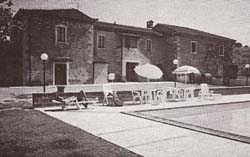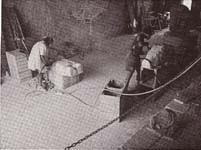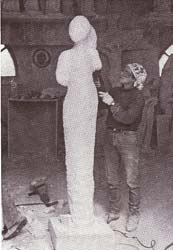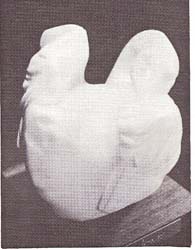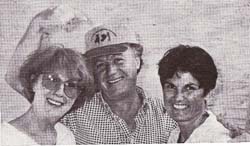- Details
-
Created: Monday, 02 November 1998 06:59
NWSSA member and stone sculptor, Gary McWilliams, is a modern day explorer of new and unusual sculpting stone. He ha used his charter boat, the M/V Hyak, for the last several years in southeast Alaska. Michael Jacobsen's sculpture, "Aphrodit, Rising," shown on the cover was sculptedfrom another Alaskan marble quarried and collected by Gary McWilliams.
Not many people set foot on the west side of Dall Island. Commercial fishing boats pass by, but few fishermen take time to anchor and wander its craggy shores. Pleasure boats seldom venture in the area, its waters too well known for high seas, swift currents, and hidden rocks. The west side of Dall Island is not en route to anywhere else; only open Pacific lies beyond. Anyone who gets to the outside of Dall Island must really want to go there.
I really want to go there, to return to a certain spot I marked with an "X" on my nautical chart in 1992. My charter boat, the MN Hyak, was serving then as a floating base camp for government geologists. While at anchor in one of the many bays on Dall's west side, I found an outcrop on shore of a beautiful coJored marble. I had opportunity then to only pick up a couple loose lying stones on the beach and to mark this "X" on the chart before me now. Over the following winter, I cut one of the stones I found with my rock saw and polished the slabs. A sculptor in Seattle made a very attractive bowl from another stone I picked up. A third piece went to a man who makes spheres with lapidary equipment. The small sphere he made of the material, an inch-and-a-half in diameter, turned out beautifully. The marble is brightly banded, with red, green, purple, yellow, and white stripes. Its reds and purples predominate. Viewers of that first sphere commented, "It looks just like Jupiter." The name stuck. I called the marble "Alaskan Jupiter."
Tomorrow, finally, I head the Hyak south to that "X" that has enticed me for so long. The time and place are finally right-my charter season is over and, having relocated my boat business to Craig, on Prince of Wales, I reside much closer to Dall Island. Because the site is in the Tongass National Forest, I obtain a Forest Service "Special Use" permit for the collection of stone. Mike Kampnich will take time off from his job as Craig's Harbor Master to join me on the trip. Mike is sure to be a great asset. He is "boatwise." He loves beautiful stone, having caught some of the "rock pox" himself. And, a muscular fellow, he won't shy when carrying time comes. I figure five days for the tri~ one day to get there, one day back, three days at the site.
September 12,1997
The weather report calls for northwest winds, 20 to 25 knots. For the mariner in southeast Alaska, northwest winds are a mixed blessing. On the positive side, they mean clear weather. The distant snow-clad mountains can be appreciated in all their glory, the whales and porpoises can be watched a mile off; the overall visibility is excellent. On the negative side, these winds can churn some very uncomfortable seas, often as a steep chop that is no fun at all. The first twenty miles of the trip from Craig to the marble site at the south end of Dall Island is in protected waters, in the lee of other offshore islands. While running, Mike and I secure everything on the boat that can go flying once we encounter the open ocean. Entering the pass between islands that leads to the outside Pacific, we see rolling white caps ahead.
On the outside, we turn southeast, running parallel and about a mile offDall Island's coast. The seas, out of the northwest, come from behind. Being a 50' long, cigarshaped boat, the Hyak rides well in a following sea. But, shallow drafted, she is not designed as an open ocean craft. The waves we encounter, about eight feet from trough to crest, push her comfortable limit. The boat pitches up and down like a seesaw. In the wheelhouse, we hold only blue sky out our forward windows; when she plows bow down, we see only green water. Sometimes, the Hyak buries her nose as she descends from a crest, sending back a flood of water over the decks when she rises again. The seas build-we think to about ten feet-as the afternoon progresses. We slow to half speed and discuss ducking into the next available anchorage and waiting until morning, when northwest seas are typically a little calmer. We opt to keep going. It is not much further. We make our anchorage shortly before nightfall. We took our beating on the outside for five hours.
September 13, 1997
We tow a 14' aluminum skiff behind the Hyak, our means of going ashore. Mike and I tie the skiff alongside the Hyak, mount its outboard, load my hand quarrying tools-a pick and a shovel, a variety of big hammers and chisels, long pry bars and wedges. On shore, we find the Jupiter marble where I had marked it. With its colors highlighted by the remaining morning dew, it is even more beautiful in place than in memory.
Climbing from Neptune's dark domain, the ten-foot wide marble seam runs perpendicular to the beach, then disappears, after about fifty feet of barnacle-clad exposure, under a dense growth of the island's rainforest. Unfortunately, as we study the marble, Our appreciation of its beauty transforms into disappointment-we realize that the seam can yield little, if any, stone. The marble stratum is vertically dipping-lying on end, virtually straight up and down. Relatively soft, the marble is eroded down to several feet below the nonmarble strata enclosing it. It is Structurally walled in. And, without cracks, there is no place to work in a bar or wedge. Nothing can be pried loose. We don't find any nice loose stones lying about either. I must have picked up the few there five years ago.
Yet hope to frod beautiful sculpting stone springs eternal. The marble stratum we observe on the beach has a very distinct strike, or directionality. Perhaps by walking in the direction it runs, we can find the marble seam in an outcrop somewhere in the woods. I motor the skiff back to the Hyak to get my compass. After taking the seam's bearing, Mike and I head inland. One typically does not look for rock in the Alaskan rainforest. The reason is simple: no rock can be seen. Great trees of Sitka spruce, Western hemlock, and red or yellow cedar, both standing and fallen, cover much of the ground. The forest's second canopy-head high huckleberry, salmonberry, and Devils club-makes it impossible in many places to see a hand in front of your face. Closer to the ground, your seldom-seen feet must find their way by feel and the grace of God beneath a cover of ferns, brambles, and skunk cabbage. Below that is a six-inch-deep mat of moss. Below that are roots, duff, and dirt. Generally speaking, you cannot find an exposed rock on a bet. Yet Mike and I have no choice. If we are to find any "Jupiter" marble, it must Come from some place inland.
The strike of the marble seam leads us along a hillside that inclines at about 40 degrees. The terrain, characteristic of limestone topography (marble is metamorphic limestone) is wrinkled with ridges and gullies. We locate some rock exposures along the ridge sides and occasional loose boulders in the gullies. We peel back their moss coverings to see what lies beneath. Rarely we frod places where the rock is totally bare and readily observable. No "Jupiter" marble. Mike and I crisscross the hillside all day. Unless the seam has been offset by some past earth movement, we know from our compass bearing that, at times, we must be walking over it.
Tired and discouraged by late afternoon, Mike and I begin Our return to the beach where we left the skiff. Off to Our right, I see a well-known and pleasing sight-the bright orange of "chicken of the woods" mushrooms. (These mushrooms, which grow in shelves on the sides of decaying trees, are delicious when sauteed with butter, garlic, and a pinch of nutmeg. ) We veer off course to pick a few for dinner. Walking parallel to me a hundred feet away, Mike shouts, "Forget the mushrooms; come here." He sounds very excited. I beat through the brush to frod him on his hands and knees over an exposure of bare rock. He found the "Jupiter" marble.
Mike and I strip away the moss covering nearby rocks. As we lay bare the beautiful body of rock underneath, we plainly see that we have an actual outcrop of the marble seam and not just a loose boulder or two moved there by glacial or gravitational forces. We had walked by this outcrop, a twenty-by-fifty foot hump of rock, several times earlier and had missed this little window into its content that Mike had chanced upon. It is visible only from its uphill side and from only the precise route Mike had walked. It would not have been seen at all if it were not for the beckon of the wild mushrooms. The day has progressed too far to do more than simply admire our discovery and pluck some tasty supplements to dinner. Marking our trail with care, we return to the skiff.
September 14,1997
Digging through moss and dirt, we pull out loose stones and place them by our trailhead. Although the seam itself is still very much attached to mother earth, the rocks we extract from around its base are loose, held in place by only the dirt and debris of the forest floor. Marble (and limestone) has a characteristic manner of erosion, one easy to discern once known. Most of its erosion results from chemical dissolution, that is, in the presence of water; it simply dissolves away over time. This is how caves form. If a body of rock has a crack, due perhaps to an earth movement-remember plate tectonics-water can penetrate, dissolving its waBs, widening the breach. Freezing in winter, expanding water contributes to the splitting process in a secondary, mechanical way. Growing and pushing, penetrating tree roots add an organic component to the de-constructive process. Eventually, the cracked portions of the seam separate totally from the parent rock. The sloughed rocks that Mike and I find hidden under the moss and duff of the forest floor would dissolve away to nothing if left in place in their water-saturated environment. Shaped by running water and dissolution, marble (or limestone) rocks can themselves be wonderful sculpture. Smooth, rounded edges and holes passing through the entirety of the rock are characteristic. Beyond improvement by the hand of man, many of the rocks we lay aside will be reserved as "natural sculpture. "
September 15,1997
Carrying day. The rocks we jam into our backpacks weigh from thirty to one hundred pounds. There may be twelve hundred pounds all together. Our trail zigzags downhill, a distance of about one hundred yards. There are logs to climb over, branches of wiry huckleberry to snare our feet, broad briar-laden leaves of Devils club to swish our hands and faces. There are several very steep sections that we mainly slide down. The main concern is footing-to not twist an ankle or a knee.
Taking our time, we get all the rocks to the beach but one last big one. I think it is simply too big. Yet I really love it. Its natural shape suggests a whale's head. It has a perfectly placed eye, an eroded hole passing entirely through it. I figure it weighs 250 pounds. Mike says, "We can carry it." ''No way," I answer. We sit on the hillside and think about it. A plan evolves.
We return to the skiff and load the stone already carried to the beach. We take the skiff to the Hyak and off-load the stone, then find a wood saw, a section of old rope, and some heavy seine net that I have stowed in my "might-need-someday" store of odds and ends. Back at the marble site, we cut a small sapling to use as a pole and lash the net to it with the rope. Mike is sure the two of us together can sling the big stone down the hill. While I know he can carry his end-I'd already seen him shoulder hig bucks out of the woods during hunting season-I doubt even more when I first heft mine. "Come on," he encourages. "We can do it."
Mike leads. Having the downhill side, he packs the most weight, but he has the advantage of seeing where to place his feet. The rock swinging between us blocks my view. I often trip, dumping my end. The steep portions of the trail bring welcome relief-we drop the stone and roll it down. Still, by the time we reach the beach, my knee muscles are in spasms and my right shoulder feels like it may forever tilt an inch closer to the ground.
We lift the big stone into the skiff, but make no attempt to lift it out again onto the Hyak, to place with the rest of the marble now sitting on the aft deck. I have towed the skiff well enough before with one or two big rocks left inside and I figure to do it again.
September 16,1997
We have had only blue skies and northwest winds since the beginning of our trip---excellent weather for dinner on the fore deck or for photographing the fine waterfall behind our anchorage, but lousy for running a boat in open waters. We depart our anchorage to confront the same eight to ten foot waves as before. Our return run heads us directly into the oncoming seas. Thinking we can slog through if we go slowly enough, we beat into white blowing water for several hours. The scenery on the Dall Island shore, now on our starboard side, radiates in its clarity and beauty, but we wish it would pass by a little faster. The skiff towed behind us bucks wildly up and down, spraying water in big arcs from along its sides.
We plod on. After two hours, the radar indicates only seven miles made good from our starting point. We are taking more water than I like over the fore deck. I am concerned about the rocks on the aft deck. Although we secured them pretty well in place, by wedging them against each other and the bulwark, they certainly could create an unwelcome havoc, and a dangerous instability, if they suddenly let go and slide. I ask Mike to go aft to check on things. I hear him bellow over the wind, "The skiff is gone."
"Whatl" I look behind the Hyak and see only blue water and the tow line, its parted far end skittering over the waves. The added weight of that big rock and the up-and-down sea's snapping of the line surely caused the failure. We turnaround, taking the invariable few licks on the beam as we do. TIrrough binoculars, we spot the little boat, when both it and we are on top of waves. The skiff looks a mile or so behind.
I bring the Hyak to near alongside the bobbing 14' boat. We use a pike pole (a long aluminum pole with a hook on the end) to pull it in closer. With a replacement line in hand, Mike waits fur the right moment to jump from the rising and falling Hyak into the rising and falling skiff. I attempt to both keep the Hyak headed into the waves to minimize her rolling and to hold the skiff close-to with the pike pole. Mike jumps, ties the new line to the skiffs tow cleat with a bowline, and jumps back.
Having had about as much of this fun as we can stand, we decide to proceed south and return to Craig the long way, by going around Dall's southern end and coming up its protected east side. Doing so adds twenty miles to our return but it puts these unruly seas astern, where the Hyak can better ride them. A five-hour journey in good weather, our homebound trip takes us fourteen.
Prospecting for stone in the still wild areas of Alaska is the first great pleasure. Finding a beautiful new sculpting stone, one that has never been worked, indeed never been seen, is the second pleasure. As in the rmding of the Jupiter marble, it can be a thrill. "Quarrying," although it resembles work at times, may be fulfilling in its challenge. The hard part is getting the stone from the remote Alaskan sites where nature put it to artists whose studios may be hundreds, or thousands, of miles away. Many handlings are required, both in Alaska and at the other end of the barge line in Seattle. The stone, usually mud-caked at extraction, has to be cleaned with high-pressure water. I always look forward to this first revealing of the stone's full natural beauty, a process that brings "oohs" and "ahhs" from spectators. My greatest pleasure is seeing stone I found displayed and appreciated as fine sculpture.
- Details
-
Created: Wednesday, 02 September 1998 06:16
Your lifestyle requires money! Achieve itll And account for it!!
Generally, the artist in business alone is operating under a Sole Proprietorship (one individual or a married couple). This is a common form of business structure. Also available is a General Partnership, a Limited Partnership or a Corporation.
In Washington state, registering a business is a onetime requirement. You do this by filling out a Master Application-Washington's basic business application provided by the Department of Licensing (Olympia: 360-753-4401). There is an application fee of S15. You will receive a Unified Business Identifier (UPI), a nine-digit number to be used to identify the business.
Registering your business will set into action the fOllowing registrations that do not require a fee:
- Tax Registration: You will be registered with the Department of Revenue if you produce or sell a product or provide a service.
- Industrial Insurance: If you employ one or more people, you must apply for this coverage. You can also order industrial insurance coverage for yourself You will be registered for this through the Department of Labor and Industries.
- Unemployment Insurance: If you employ one or more persons, you must provide this coverage for them. You will be registered for this through the Employment Security Department. If your spouse is on the payroll, he/she is not eligible for this benefit on the state or federal level. (Wash. Rev. Code 50.04.180).
SALES TAX
The Department of Revenue will provide you with a packet explaining how to report your taxes and your assigned reporting frequency. Not all your purchases are subject to sales tax when the article or material is purchased, if the purchase has a business purpose. For Imple, sales tax may not apply if it is:
- To be resold.
- To be incorporated into a new product being produced for sale.
- A chemical used to process a product which wi be sold. (Note: paints, polishes, washes all fall into this category)
An example: Daniel Smith, a Seattle-based retail store for art materials, requires the artist to complete a form which is entered into their computer system. When artist makes purchases, the UBI number is given a the sales tax is deleted from the purchase.
The sales tax on the original materials will be deferr until you sell it. You are responsible for collecting saI tax on the fair market value of your art when it is sol This UPI number will prevent you from paying saIl tax twice on the art you sell.
FORMS OF TAXABLE INCOME
- The fair market value of your art is generally th price to which a buyer and seller would agree Valuation is important when the artist realize: income in the fonn of goods or senices. This is particularly important to the artist who gives art. work in exchange for the services of professionals, such as lawyers, doctors and dentists. This is considered a sale and therefore taxable income. A third party evaluation may be necessa.ry for establishing value for IRS.
- Another form of taxable income is if your artwork is stolen or destroyed, and insurance reimburses you for the value. The insurance proceeds are taxable, as if a sale has occurred. But at least you can deduct your insurance premiums.
INFORMAL RECORDS AND FORMAL RECORDS
Start by learning a new set of "3 R' s" -record keeping, record keeping and (you guessed it) record keeping. IRS studies show that poor records, not dishonesty, are what cause most small businesses to lose at audits or fail to properly comply with their tax reporting obligations, with resulting fines and penalties. Being a self-employed artist, you should record business income and expenses. This can be tricky, however, until you understand what kinds of records back up deductions. For IRS, it's best to keep two types of documents - informal records and formal records.
All the papers you receive in the course of business: canceled checks, bank statements, bills, receipts. All activities in connection with your artwork, no matter how small the amount. A check alone isn't always accepted as proof by IRS so make sure you get an itemized bill or receipt whether you pay by cash or check.
Have a separate bank account to maintain accurate records, deposit all income earned through your art, and pay for all expenses out of that same account. If you personally support yourself by another business and your art expenses are too high, write yourself a check from your personal account as a loan and keep a record so this can be paid back when pieces sell. Better yet, write a fomtal loan statement for your records.
Formal records: These list or summarize income and expenses and should be kept by either single-entry or double-entry bookkeeping. Single-entry lets you list all your expenses as they're incurred so you can add them up at the end of the year. All you need to say about most expenses in this fomtal record is what they were and how much they cost. This can even be done in a simple pocket diary, however, more elaborate systems can be found at any stationery store.
PROFESSIONAL EXPENSES
Separate the billing statements or receipts by cateory, such as:
- Art materials and supplies
- Work space
- Office equipment
- Certain books and magazines
- Promotional e.\]lenses
- Telephone, POstage
- Premiums for art insurance
- Commissions of agents
- Legal and accounting fees
- Auto expenses
Put your documents into individual folders or envelopes. If you are ever audited, the IRS is most likely to zero in on business deductions for travel and entertainment and car expenses. Furthermore, the burden will be on you-not the IRS-to substantiate your deductions.
To ensure you're on the right track, it's a good idea to run your bookkeeping system by a savvy small business tax pro. With just a few hours of work, they could help you avoid the most common mistakes and show you how to dovetail your bookkeeping system with tax-filing requirements.
Classes to assist in record keeping as well as other business topics are sponsored by the IRS and Small Business Administration (SBA). Check their web page when you go on-line (www.sbaonline.sba.gov) for infonnation such as:
- Small Business Tax Workshop for New Businesses: SBDC, SIRTI Bldg., 665 N. Riverpoint Blvd., Spokane, WA 99202; 509-358-7890.
- In Seattle, seminars are held at Jackson Federal Building, 915 Second Avenue, Seattle, W A 99184-9902; 206-220-5776.
- In BC, the Canada-British Columbia Web site has a large data base of government programs:
- WWW.cbsc.org/bc
Business-oriented information phone numbers for NWSSA territory:
- Anchorage, AK: 907-271-4022
- Boise, ill: 208-0334-1696
- Portland, OR: 503-326-2682
- Seattle, WA: 206-553-7310
- Spokane, WA: 509-353-2800
- Vancouver, BC: 604-775-5525; 800-667-2272
IRA-KEOGB-THE EARLIER YOU START, THE BETTER
When you earn money with your artwork, you will pay Social Security taxes-Why not add to your future with tax-deductible retirement funds. The most important part of having a nest egg is not how much you can put aside, but how long you can put it aside. Your lifestyle requires money-face it! (Have you read this before?)
One area is which you, as an artist, can augment your prescnt income is the tax-sheltered savings plans. You cannot be too busy to consider these issues. The tax deferral benefits of the Keogh (for self employed), the IRA, and the Roth IRA are worth your investigation. With the IRA, contributions are tax deductible with taxes paid at withdrawal and with the Roth IRA, contributions are not tax deductible, however, the earnings are tax free. Do some homework-you can even establish your account with a discount broker (minimum charges) such as Charles Schwab so you can manage your own funds.
To find out where you stand today, a phone call could get you started. Call the Social Security Administration (1-800-772-1213) for Fonn SSA-7004. You will find out just how much you have paid in-and an estimate of the benefits you will have available when you start drawing on them.
DEATH AND DIVORCE - WHICHEVER COMES FIRST
Estate planning: Think about what could happen if you were out of the picture tomorrow.
Death can be one cause; disability due to accident or illness is a real possibility as well. No one should handle all the planning alone. Look over your studio or workshop and make an inventory. List your pieces with relevant infonnation that would be useful for valuation. Estate planning involves deciding how you want to distribute your assets, including your artwork, following your death ... and selecting the people or institutions to carry out your plans.
Whether your estate plan is complex or simple, you should have a w:i11 as part of that plan. Many states require, and it is generally a good idea, that an attorney draft your will. State laws differ on issues ranging from the details and Signing, dating and witneSSing, to the very defmition of words and phrases used in wills. This w:i11 can also include trusts and name trustees (persons and institutions).
Community property: This is an interesting law to deal with in Washington state. The following example of a Seattle artist caught up with it all can give you something to think about.
As the divorce started taking form, the division of property included artwork produced during the union. Several pieces of artwork had been sold during the 17-year marriage and the artist was represented by a gallery in Seattle. The courts required the gallery to take an inventory of the work assigned to it and give the total fair market value. At the time, there were over ten pieces of sculpture to be sold by the gallery. The artist, in order to keep control of the work, had to purchase the spouse's half of the sculptures. If you have multiple residences or studios in different states, the process is further complicated. Different states and provinces have different tax structures and rates. There could be a challenge to the location of your prinCiple residence for tax purposes. Talk to an attorney about how to prevent predictable problems. In fact, the last sentence is pretty good advice for most of your business decisions.
My focus for these five articles has been to intrigue the minds of stone carvers in areas they may not have considered-at least get you a little curiousll I hope I have accomplished this objective.
And now (after this article was written in July) on to ltalia where Tamara and I will be (were) working for the month of August with Mauro Berrettini and Claire MCArdle in Rapolano-a little hill town just outside Siena. But for now (watch me play this out as long as I can) I will say, arrivederci!
Patrizia
© 1998 Patricia Sekor
Resource list: Operating a Business in Washington State, Department of Licensing, Olympia, WA; Business Tax Seminars, Internal Revenue Service, Seattle, W A; Tax and License Infonnation, SBA, Seattle, WA; Art Calendar, November, 1997, Estate Planning, Laurel Lesser Zimet.
